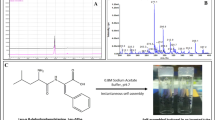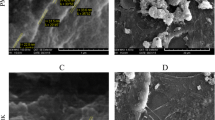Abstract
Physical properties of a tissue engineering scaffold play a crucial role in maneuvering the cellular fate. Scaffold properties have been shown to significantly influence cellular growth kinetics as well as overall cell behavior. The purpose of the present investigation was to investigate the effect of varying physical properties of a dipeptide-hydrogel, on the nature of growth and spreading pattern of C6 glial cells cultured on it. It was observed that the dipeptide, phenylalanine-dehydrophenylalanine (Phe-ΔPhe), which could form stable self-supportive hydrogel after self-assembly, demonstrated diverse physical properties like variation in fiber dimensions based on the conditions under which it was made to self-assemble. These gel parameters further controlled the nature of glial cell viability, growth, and spreading on them. With such tunability in scaffold properties along with the differential glial cell growth supporting behavior, this dipeptide hydrogel offers great potential for being used as a neural tissue engineering scaffold.
Graphic Abstract
Graphical illustration of biocompatible dipeptide (FΔF) gel formation by virtue of self-assembly phenomenon at various solvents and salt concentrations and its impact on glial cells (C6) growth. The experiment demonstrated formation of hydrogels with different fiber dimensions on variation of self-assembling conditions such as salt concentration/solvent which modulated cellular behavior, especially the growth and spreading of glial cells on the dipeptide hydrogels with varied fiber properties.








Similar content being viewed by others
References
Adams DJ (2011) Dipeptide and tripeptide conjugates as low-molecular-weight hydrogelators. Macromol Biosci 11:160–173. https://doi.org/10.1002/mabi.201000316
Adhikari B, Palui G, Banerjee A (2009) Self-assembling tripeptide based hydrogels and their use in removal of dyes from waste-water. Soft Matter 5:3452–3460. https://doi.org/10.1039/B905985G
Badami AS, Kreke MR, Thompson MS, Riffle JS, Goldstein AS (2006) Effect of fiber diameter on spreading, proliferation, and differentiation of osteoblastic cells on electrospun poly (lactic acid) substrates. Biomaterials 27:596–606. https://doi.org/10.1016/j.biomaterials.2005.05.084
Bhattacharya S, Acharya SG (1999) Impressive gelation in organic solvents by synthetic, low molecular mass, self-organizing urethane amides of L-phenylalanine. Chem Mater 11:3121–3132. https://doi.org/10.1021/cm990207v
Brownsey GJ (1993) Thermoreversible gelation of polymers and biopolymers. By Jean‐Michel Guenet, Academic Press, London 1992, 278 pp., ISBN 0‐12‐305380‐5. Adv Mater 5:220–221. https://doi.org/10.1002/adma.19930050316.
Budyanto L, Goh YQ, Ooi CP (2009) Fabrication of porous poly (L-lactide) (PLLA) scaffolds for tissue engineering using liquid–liquid phase separation and freeze extraction. J Mater Sci - Mater Med 20:105–111. https://doi.org/10.1007/s10856-008-3545-8
Chan BP, Leong KW (2008) Scaffolding in tissue engineering: general approaches and tissue-specific considerations. Eur Spine J 17:467–479. https://doi.org/10.1007/s00586-008-0745-3
Chen M, Patra PK, Warner SB, Bhowmick S (2007) Role of fiber diameter in adhesion and proliferation of NIH 3T3 fibroblast on electrospun polycaprolactone scaffolds. Tissue Eng 13:579–587. https://doi.org/10.1089/ten.2006.0205
Chen L, Raeburn J, Sutton S, Spiller DG, Williams J, Sharp JS, Furzeland S (2011) Tuneable mechanical properties in low molecular weight gels. Soft Matter 7:9721–9727. https://doi.org/10.1039/C1SM05827D
Christopherson GT, Song H, Mao HQ (2009) The influence of fiber diameter of electrospun substrates on neural stem cell differentiation and proliferation. Biomaterials 30:556–564. https://doi.org/10.1016/j.biomaterials.2008.10.004
Chung S, Ingle NP, Montero GA, Kim SH, King MW (2010) Bioresorbable elastomeric vascular tissue engineering scaffolds via melt spinning and electrospinning. Acta Biomater 6:1958–1967. https://doi.org/10.1016/j.actbio.2009.12.007
Discher DE, Janmey P, Wang YL (2005) Tissue cells feel and respond to the stiffness of their substrate. Science 310:1139–1143. https://doi.org/10.1126/science.1116995
Dou XQ, Feng CL (2017) Amino acids and peptide-based supramolecular hydrogels for three-dimensional cell culture. Adv Mater 29:1604062. https://doi.org/10.1002/adma.201604062
Dube T, Mandal S, Panda JJ (2017) Nanoparticles generated from a tryptophan derivative: physical characterization and anti-cancer drug delivery. Amino Acids 49:975–993. https://doi.org/10.1007/s00726-017-2403-8
Estroff LA, Hamilton AD (2004) Water gelation by small organic molecules. Chem Rev 104:1201–1218. https://doi.org/10.1021/cr0302049
Georges PC, Miller WJ, Meaney DF, Sawyer ES, Janmey PA (2006) Matrices with compliance comparable to that of brain tissue select neuronal over glial growth in mixed cortical cultures. Biophys J 90:3012–3018. https://doi.org/10.1529/biophysj.105.073114
He L, Liao S, Quan D, Ma K, Chan C, Ramakrishna S, Lu J (2010) Synergistic effects of electrospun PLLA fiber dimension and pattern on neonatal mouse cerebellum C17. 2 stem cells. Acta Biomaterialia 6:2960–2969. https://doi.org/10.1016/j.actbio.2010.02.039
Her GJ, Wu HC, Chen MH, Chen MY, Chang SC, Wang TW (2013) Control of three-dimensional substrate stiffness to manipulate mesenchymal stem cell fate toward neuronal or glial lineages. Acta Biomater 9:5170–5180. https://doi.org/10.1016/j.actbio.2012.10.012
Hodgkinson T, Yuan XF, Bayat A (2014) Electrospun silk fibroin fiber diameter influences in vitro dermal fibroblast behavior and promotes healing of ex vivo wound models. J Tissue Eng 5:2041731414551661. https://doi.org/10.1177/2041731414551661
Hong Y, Pritzker MD, Legge RL, Chen P (2005) Effect of NaCl and peptide concentration on the self-assembly of an ionic-complementary peptide EAK16-II. Colloids Surf, B 46:152–161. https://doi.org/10.1016/j.colsurfb.2005.11.004
Hsieh A, Zahir T, Lapitsky Y, Amsden B, Wan W, Shoichet MS (2010) Hydrogel/electrospun fiber composites influence neural stem/progenitor cell fate. Soft Matter 6:2227–2237. https://doi.org/10.1039/B924349F
Hunt JA, Chen R, van Veen T, Bryan N (2014) Hydrogels for tissue engineering and regenerative medicine. J Mater Chem B 2:5319–5338. https://doi.org/10.1039/C4TB00775A
Kopecek J (2007) Hydrogel biomaterials: a smart future? Biomaterials 28:5185–5192. https://doi.org/10.1016/j.biomaterials.2007.07.044
Kothapalli CR, Kamm RD (2013) 3D matrix microenvironment for targeted differentiation of embryonic stem cells into neural and glial lineages. Biomaterials 34:5995–6007. https://doi.org/10.1016/j.biomaterials.2013.04.042
Koutsopoulos S (2016) Self-assembling peptide nanofiber hydrogels in tissue engineering and regenerative medicine: Progress, design guidelines, and applications. J Biomed Mater Res, Part A 104:1002–1016. https://doi.org/10.1002/jbm.a.35638
Li WJ, Tuli R, Okafor C, Derfoul A, Danielson KG, Hall DJ, Tuan RS (2005) A three-dimensional nanofibrous scaffold for cartilage tissue engineering using human mesenchymal stem cells. Biomaterials 26:599–609. https://doi.org/10.1016/j.biomaterials.2004.03.005
Li Y, Wang F, Cui H (2016) Peptide-based supramolecular hydrogels for delivery of biologics. Bioeng Transl Med 1:306–322. https://doi.org/10.1002/btm2.10041
Liebmann T, Rydholm S, Akpe V, Brismar H (2007) Self-assembling Fmoc dipeptide hydrogel for in situ 3D cell culturing. BMC Biotechnol 7:1–11. https://doi.org/10.1186/1472-6750-7-88
Loo Y, Goktas M, Tekinay AB, Guler MO, Hauser CA, Mitraki A (2015) Self-assembled proteins and peptides as scaffolds for tissue regeneration. Adv Healthcare Mater 4:2557–2586. https://doi.org/10.1002/adhm.201500402
Mobarakeh LG, Prabhakaran MP, Tian L, Jeshvaghani ES, Dehghani L, Ramakrishna S (2015) Structural properties of scaffolds: crucial parameters towards stem cells differentiation. World J Stem Cells 7:728. https://doi.org/10.4252/wjsc.v7.i4.728
Murphy CM, O’Brien FJ (2010) Understanding the effect of mean pore size on cell activity in collagen-glycosaminoglycan scaffolds. Cell Adh Migr 4:377–381. https://doi.org/10.4161/cam.4.3.11747
Nagahama K, Ouchi T, Ohya Y (2008) Temperature-induced hydrogels through self-assembly of cholesterol-substituted star PEG-b-PLLA copolymers: an injectable scaffold for tissue engineering. Adv Func Mater 18:1220–1231. https://doi.org/10.1002/adfm.200700587
Noriega SE, Hasanova GI, Schneider MJ, Larsen GF, Subramanian A (2012) Effect of fiber diameter on the spreading, proliferation and differentiation of chondrocytes on electrospun chitosan matrices. Cells Tissues Organs 195:207–221. https://doi.org/10.1159/000325144
Nowak AP, Breedveld V, Pakstis L, Ozbas B, Pine DJ, Pochan D, Deming TJ (2002) Rapidly recovering hydrogel scaffolds from self-assembling diblock copolypeptide amphiphiles. Nature 417:424–428. https://doi.org/10.1038/417424a
Ozbas B, Kretsinger J, Rajagopal K, Schneider JP, Pochan DJ (2004) Salt-triggered peptide folding and consequent self-assembly into hydrogels with tunable modulus. Macromolecules 37:7331–7337. https://doi.org/10.1021/ma0491762
Panda JJ, Mishra A, Basu A, Chauhan VS (2008) Stimuli responsive self-assembled hydrogel of a low molecular weight free dipeptide with potential for tunable drug delivery. Biomacromol 9:2244–2250. https://doi.org/10.1021/bm800404z
Panda JJ, Kaul A, Kumar S, Alam S, Mishra AK, Kundu GC, Chauhan VS (2013) Modified dipeptide-based nanoparticles: vehicles for targeted tumor drug delivery. Nanomedicine 8:1927–1942. https://doi.org/10.2217/nnm.12.201
Raeburn J, Pont G, Chen L, Cesbron Y, Levy R, Adams DJ (2012) Fmoc-diphenylalanine hydrogels: understanding the variability in reported mechanical properties. Soft Matter 8:1168–1174. https://doi.org/10.1039/C1SM06929B
Raeburn J, Mendoza-Cuenca C, Cattoz BN, Little MA, Terry AE, Cardoso AZ, Adams DJ (2015) The effect of solvent choice on the gelation and final hydrogel properties of Fmoc–diphenylalanine. Soft Matter 11:927–935. https://doi.org/10.1039/C4SM02256D
Schwarz US, Bischofs IB (2005) Physical determinants of cell organization in soft media. Med Eng Phys 27:763–772. https://doi.org/10.1016/j.medengphy.2005.04.007
Soliman S, Pagliari S, Rinaldi A, Forte G, Fiaccavento R, Pagliari F, Traversa E (2010) Multiscale three-dimensional scaffolds for soft tissue engineering via multimodal electrospinning. Acta Biomater 6:1227–1237. https://doi.org/10.1016/j.actbio.2009.10.051
Sultana N, Wang M (2012) PHBV/PLLA-based composite scaffolds fabricated using an emulsion freezing/freeze-drying technique for bone tissue engineering: surface modification and in vitro biological evaluation. Biofabrication 4:015003. https://doi.org/10.1088/1758-5082/4/1/015003
Sun J, Zhang H, Guo K, Yuan S (2015) Self-assembly of dipeptide sodium salts derived from alanine: a molecular dynamics study. RSC Adv 5:102182–102190. https://doi.org/10.1039/C5RA19508J
Thota CK, Yadav N, Chauhan VS (2016) A novel highly stable and injectable hydrogel based on a conformationally restricted ultrashort peptide. Sci Rep 6:1–12. https://doi.org/10.1038/srep31167
Timm M, Saaby L, Moesby L, Hansen EW (2013) Considerations regarding use of solvents in in vitro cell based assays. Cytotechnology 65:887–894. https://doi.org/10.1007/s10616-012-9530-6
Zhang S, Marini DM, Hwang W, Santoso S (2002) Design of nanostructured biological materials through self-assembly of peptides and proteins. Curr Opin Chem Biol 6:865–871. https://doi.org/10.1016/S1367-5931(02)00391-5
Acknowledgements
This work was partially supported by the Inspire Faculty Fellowship program of Department of Science and Technology, India and the core grant of Institute of Nano Science and Technology and DBT BIOCARE grant and ICMR-DHR International Fellowship program and Har Gobind Khorana IYBA-program of DBT, India.
Author information
Authors and Affiliations
Corresponding authors
Additional information
Publisher's Note
Springer Nature remains neutral with regard to jurisdictional claims in published maps and institutional affiliations.
Supplementary Information
Below is the link to the electronic supplementary material.
Rights and permissions
About this article
Cite this article
Mandal, S., Dube, T., Mohapatra, A.K. et al. Engineered Biocompatible and Stable Dipeptide Hydrogel with Tunable Mechanical and Cell Growth Properties to Embolden Neuroglial Cell Growth. Int J Pept Res Ther 27, 2795–2808 (2021). https://doi.org/10.1007/s10989-021-10290-0
Accepted:
Published:
Issue Date:
DOI: https://doi.org/10.1007/s10989-021-10290-0




